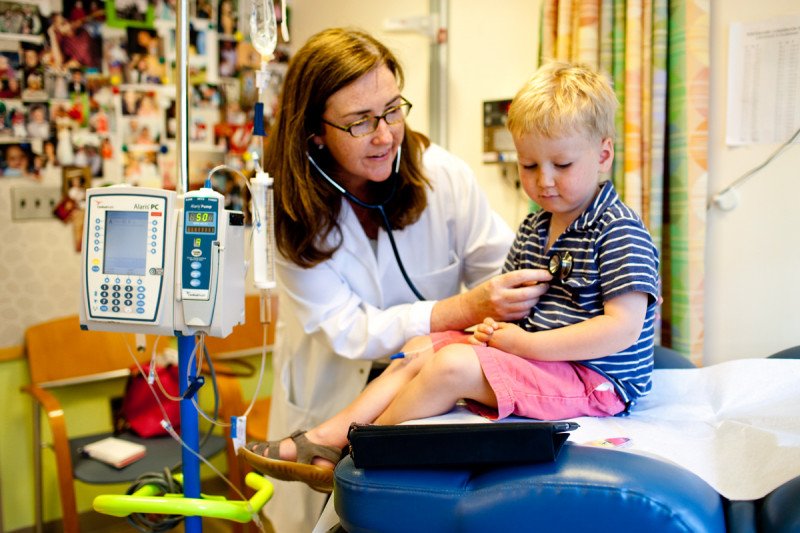
Nurse practitioner Maura Byrnes-Casey with a young patient.
Taking Aim at Pediatric Leukemia
Your child’s leukemia treatment will typically start with chemotherapy that is given in three phases: induction, consolidation, and maintenance.
- Induction therapy takes about four weeks. The goal of induction therapy is to induce remission. That means there are no detectable leukemia cells in your child’s body and normal blood cells are being produced again. During this time, your child will receive a combination of chemotherapy drugs, each one targeting leukemia cells in a different way. Some drugs are given into the spinal fluid during a procedure called a lumbar puncture. We will briefly place your child under anesthesia during this procedure and will make sure that they are comfortable. By taking aim at the cancer from different angles, our doctors hope to prevent the resistance that leukemia cells can develop to therapy. Your child’s care team will find the anticancer drugs and doses that are most effective while causing the fewest side effects, including long-term effects that can happen years later. We also give medications to relieve nausea and constipation and to protect the kidneys. We are mindful of your child’s future and do all we can to protect it.
- Consolidation therapy is the second phase of leukemia treatment. The goal is to kill any leukemia cells that may be hiding in the bone marrow, brain, and spinal cord. During consolidation, your child receives several new drugs at different dosages and schedules. These will be different from the drugs used during induction therapy. This reduces the chance of resistance developing to the chemotherapy drugs. During consolidation therapy, your child will also receive chemotherapy given directly into the spinal fluid.
- Maintenance therapy is the last phase of treatment for people with acute lymphoblastic leukemia (ALL). It lasts one to two years. It involves a combination of chemotherapy drugs given to further reduce the chance that the leukemia will come back. The intensity of the treatment will depend on your child’s risk of relapse. Your child’s care team will talk with you about the intensity of treatment and how long it will take.
Leukemia Treatments That Work
At MSK Kids, most children with acute lymphoblastic leukemia are cured with standard therapy. Ninety percent of children with standard-risk leukemia and 80 percent of those with high-risk leukemia are cured and do not experience a relapse. While that’s cause for celebration, our researchers continue to work toward a cure for children who relapse so we can get the cure rate to 100 percent for everyone.
Will my child need to stay in the hospital?
Many children with leukemia can receive their chemotherapy treatments on an outpatient basis in our Pediatric Ambulatory Care Center. If we believe that your child has a high risk of infection because their white blood cell count is too low or they need intravenous antibiotics for a fever or infection, we may provide care in our inpatient unit to keep them as safe and healthy as possible. Once their white blood cell count rises to a safe level, your child can leave the hospital and receive outpatient treatment. Your child may also need to stay home from school during times that they are at an increased risk for infection. Our doctors and nurses will let you know what to expect based on your child’s specific treatment and response to therapy.
Excellence in Bone Marrow Transplantation
Children with acute myeloid leukemia (AML) or acute lymphoblastic leukemia (ALL) who may not be cured with chemotherapy alone may benefit from a bone marrow transplant, also called a stem cell transplant. At MSK Kids, we determine the need for bone marrow transplantation early on during therapy. If your child needs a transplant, we will start working with the bone marrow transplant team right away to identify potential donors from your family and the general population through the National Marrow Donor Program. The MSK Kids bone marrow transplant team includes experts who have worked to make bone marrow transplants safer. We have developed new methods to provide transplants to patients who may not have a fully matched donor. Together, we do all we can to provide lifesaving care with minimal side effects.
What happens if my child’s leukemia comes back?
MSK Kids uses advanced techniques, such flow cytometry and next-generation sequencing, to monitor your child’s response to treatment and look for the earliest signs of relapse after treatment is over. If your child experiences a relapse of leukemia, we will design a new customized care plan to achieve another remission. This will start with another round of intensive induction therapy. MSK Kids doctors have evaluated many new drug combinations for children whose leukemia has stopped responding to standard therapies. Your child may be eligible to participate in a clinical trial of a new treatment approach.




